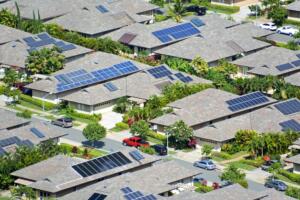 “Eco-friendly” is more than just a buzz word or concept that applies to business properties, primary residences, and your day-to-day lifestyle living in a lake home.
“Eco-friendly” is more than just a buzz word or concept that applies to business properties, primary residences, and your day-to-day lifestyle living in a lake home.
You can also extend green practices to your lake home to improve air quality and provide a cleaner, cost-efficient environment for your family and pets.
A green vacation home can also help you reduce your impact on the environment by ensuring that you do your part to help conserve and preserve natural resources.
Here are five ways you can make your vacation or lake home more eco-friendly and shrink your carbon footprint.
1. Use Green Building Materials
If you are building a new vacation home, remodeling or repairing an existing property, use green building materials. These materials are composed of renewable, sustainable resources, compared to nonrenewable resources, and have one or more of the following attributes:
- Recycled content
- Natural, plentiful or renewable
- Resource efficient manufacturing process
- Salvaged, refurbished, or re-manufactured
- Reusable or recyclable
- Durable
- Locally available
- Recycled or recyclable product packaging
Employing green materials ensures that you have a minimum impact on the environment over the life of the product. By selecting green material and reducing your carbon foot print on the environment contributes to other environmentally friendly benefits that we will discuss including air quality energy efficiency and water conservation.
2. Employ Passive Solar Techniques
 Passive solar design refers to a layout and material choice that can be used to take advantage of the sun or avoid the sun’s heat to provide comfort and conserve energy. The method has employed throughout the world as a way to create cost-effective comfort and does not require the use of solar panels.
Passive solar design refers to a layout and material choice that can be used to take advantage of the sun or avoid the sun’s heat to provide comfort and conserve energy. The method has employed throughout the world as a way to create cost-effective comfort and does not require the use of solar panels.
Passive solar systems require the home to have south-facing windows and a thermal mass. Thermal mass consist of dense materials, such as brick, concrete, stone or ceramic tile that are use inside a wall or in the floor. Located near the windows, the sun’s energy must shine directly on the selected material, which absorbs, stores and distributes heat.
The main objective of all passive solar heating systems is to capture the winter sun’s heat within the interior of the home and released the heat during periods when the sun is not shining.
Thermal mass materials can also be used to keep the structure cool during the hot summer months and to block this heat energy from entering the home and hitting the thermal mass–through the installation of an overhang on the exterior of the property or some other type of device or entryway.
After the sun has gone down and it is cool outside, your passive solar vacation home can be opened up to allow the cooler evening and night temperatures to be absorbed within the material.
3. Install an Environmentally Friendly Roof
Basically, the purpose of a roof is to protect you, your family and your personal items from the elements. However, there are a number of different types of environmentally-friendly roofing systems that can do more than protect you from, rain, snow, and the blazing sun.
You can choose a roofing system that helps keep your home cooler in the summer and help you and your family feel more comfortable and will rely on the air conditioner less.
Eco-friendly roofing systems can be use in the following manners:
- Provide a natural habitat for wildlife.
- Collect rainwater that you can use in your garden or to wash your vehicle.
- Used to grow herbs, vegetables and other plants.
For example, slate tiles can last for 100 years or more and requires minimal processing. Purchase salvaged slate if you are looking for the greenest option. If purchasing new material, select stone that is quarried in close proximity to your location in order to minimize the energy needed for transportation.
Solar roofing shingles can harvest the sunlight to power your home and provide you hot water.
4. Practice Water Conservation
Conserving water is an important aspect of creating a more eco-friendly vacation. Invest in a rain water tank. You can reuse rainwater to water plants fluster toilet or do your laundry. Improve your water efficiency by repairing a leaky faucet. A steady drip can waste 330 gallons of water each month. In addition, install the most-energy efficient hot water heater you can afford.
By installing aerating, low-flow faucets you will use 60% less water. If you have a toilet that was built before 1992, replace it with a new ultra-flush model. Even better, consider installing a composite toilet that uses little or no water and helps reduce water pollution.
5. Buy eco-friendly appliances
Make your lake home greener energy-efficient appliances. Refrigerators, air conditioners, water; heaters dishwashers and microwaves consume a significant amount of the energy. According to Energy Star, by installing energy-efficient appliances you can save up to 30% on your electricity bill.

